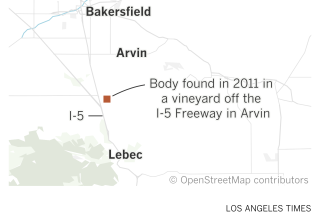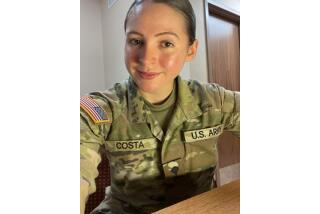Trial Starts for Man Accused of Killing Woman in 1986
- Share via
Four and a half years after the body of Jeanine Copus was found under a pile of rocks north of Ojai, the man accused of killing her went on trial for murder Monday in Ventura County Superior Court.
Thomas Gottschalk, 49, is accused of firing two .25-caliber bullets into the back of Copus’ head on July 31, 1986, and burying her under rocks in Matilija Canyon. He was the prime suspect almost immediately after the body was found about three weeks later, investigators say, but he eluded arrest until August, 1988, when a traffic officer stopped his car in Utah.
For the record:
12:00 a.m. Feb. 13, 1991 For the Record
Los Angeles Times Wednesday February 13, 1991 Ventura County Edition Metro Part B Page 4 Column 1 Zones Desk 1 inches; 28 words Type of Material: Correction
Murder trial--An article Tuesday on the murder trial of Thomas Gottchalk incorrectly identified his alleged victim. Gottchalk is accused of killing Jean Ellen Eubanks, 34, of Middletown, Calif.
In his opening statement, Deputy Dist. Atty. Richard Holmes told jurors that a thick web of circumstantial evidence will show that Gottschalk “is the only person who could have killed her.”
But Gottschalk’s attorney, Deputy Public Defender J. Steven Davidson, said he will show by direct evidence that about two weeks after Gottschalk is accused of killing Copus, she was seen getting into a pickup truck in Ojai.
Copus, 33, met Gottschalk in Middletown, a small town north of Napa, when she dated his roommate, Holmes said. She and Gottschalk spent a week in Ventura in June, 1986, as she unsuccessfully looked for work. They returned the following month to pick up a car she had stored.
On the morning of July 31, Copus told her 15-year-old daughter, Nina, to pack their belongings because they were returning to Middletown, Holmes said. Then she left with Gottschalk.
It was the last time anyone saw her alive, Holmes said.
He said he will present evidence that:
* Although no murder weapon has been found, Gottschalk owned a .25-caliber automatic before and after the crime.
* The bullets that killed Copus had an unusual manufacturing defect, and Gottschalk had bought ammunition with the same characteristics.
* Gottschalk used to swim at the same spot in Matilija Canyon where the body was found.
* When he returned to the motel where Copus’ daughter was waiting, Gottschalk told the girl that they had stopped at the storage yard where Copus left her car and that she had left with two men who helped her get it started. But computer records from the yard indicate that nobody visited their storage spot that day.
* Only Gottschalk or someone else who knew the security code at the storage yard could have removed her car, which was found about two months later in Oxnard.
* Some of Copus’ belongings that had been stored in the car were found in a canyon near Vernal, Utah, 10 days after she disappeared. Gottschalk had spent the two previous nights in Vernal, where he once had lived.
Holmes did not specify a motive for the slaying, but he said Copus had been carrying more than $2,000 in cash received as compensation for a work injury. When her body was found, her pockets had been turned inside out.
In presenting the defense case, Davidson said the evidence against Gottschalk is “largely, if not entirely circumstantial” and is “incredibly misleading.”
He said his client is not the only person who knew the spot where the body was found. He described it as a popular swimming area, as shown by a pile of litter gathered as evidence.
The man who found the body Aug. 23 had been there two weeks earlier and had not noticed the pile of rocks, Davidson said. That would have been Aug. 9, nine days after prosecutors say Copus was killed.
Davidson said Copus’ sister has said she got a call from the victim on July 31 and that Copus said she was going to party with two men she had just met. He said three witnesses will testify that they saw Copus after the day she supposedly was murdered, and four others will say they saw a woman who fit her description.
The attorney implied that investigators had focused immediately on Gottschalk and had failed to pursue other leads. For example, he said, witnesses said they had seen a woman of Copus’ description near Ojai more than a week after she disappeared, but they were not shown her photo.
Superior Court Judge James M. McNally is hearing the trial, which is expected to last six weeks. Jury selection took 11 days and more than 150 prospective jurors were interviewed before a panel of eight men and four women, plus two male alternates, was sworn.
More to Read
Sign up for Essential California
The most important California stories and recommendations in your inbox every morning.
You may occasionally receive promotional content from the Los Angeles Times.









